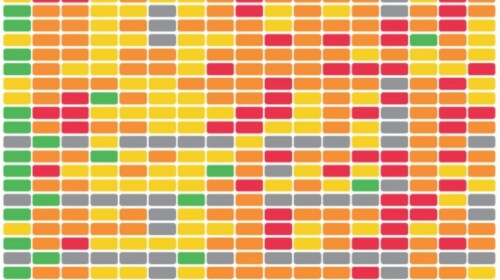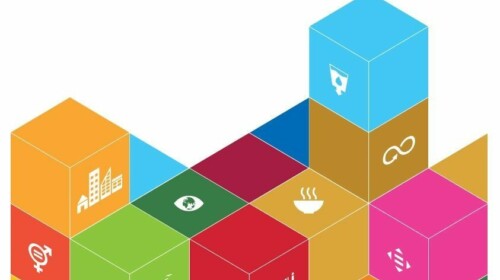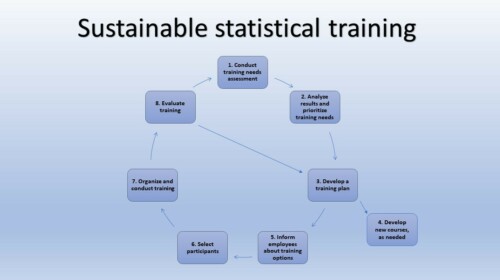“The SDGs gave a new breath to the National Statistics Committee and the opportunity to rise to prominence as the UN called upon using the official statistics. Thanks to the SDGs, the appreciation for the work and statistics produced by the NSC has significantly changed among the users.” – Nazira, Kerimalieva.
This is a blog about Ms. Nazira Kerimalieva, the First Deputy Chairman of the National Statistical Committee (NSC) of the Kyrgyz Republic, who is a dedicated public servant and has worked many years in the area of sustainable development and environment statistics in Kyrgyzstan. Through her dedication and guidance of others, the National Statistical Committee has made significant strides in implementing Sustainable Development Goals (SDG) monitoring mechanisms.
The Kyrgyz Republic has applied a unique approach to monitoring SDG indicators, focusing on multi-stakeholder engagement, communication, and innovation, and setting a benchmark for many aspiring nations in the pursuit of achieving SDGs. Nazira has passionately shared with UN SDG:Learn valuable insights from their voyage.
The Kyrgyz Approach to SDG Monitoring
As soon as the Kyrgyz Republic committed to its international obligations to implement the 2030 Agenda and its Sustainable Development Goals (SDGs), the National Statistical Committee has been diligently engaged in establishing a comprehensive framework for tracking progress and reporting on SDG indicators. Embarking on a proactive mission, the NSC carried out a thorough assessment and adaptation of a big set of SDG indicators while concurrently formulating domestic indicators tailored to the country's unique context.
From the outset, the Kyrgyz Republic adopted a multi-stakeholder approach to the SDG implementation. Moreover, as Nazira shares, the SDGs were interesting to everyone and they wanted to be part of the big global endevours. Engaging and getting feedback from a wide array of stakeholders - government bodies, civil society, business, academia and media - was foundational to ensuring that No One is Left Behind. This guaranteed that all voices were heard and integrated into the SDG monitoring framework. Together with the UN Statistics Division and other international organizations and partners within the National Statistical System (NSS), the NSC organized 40 different capacity-building workshops and trainings, roundtables, and seminars (links to the event available here).
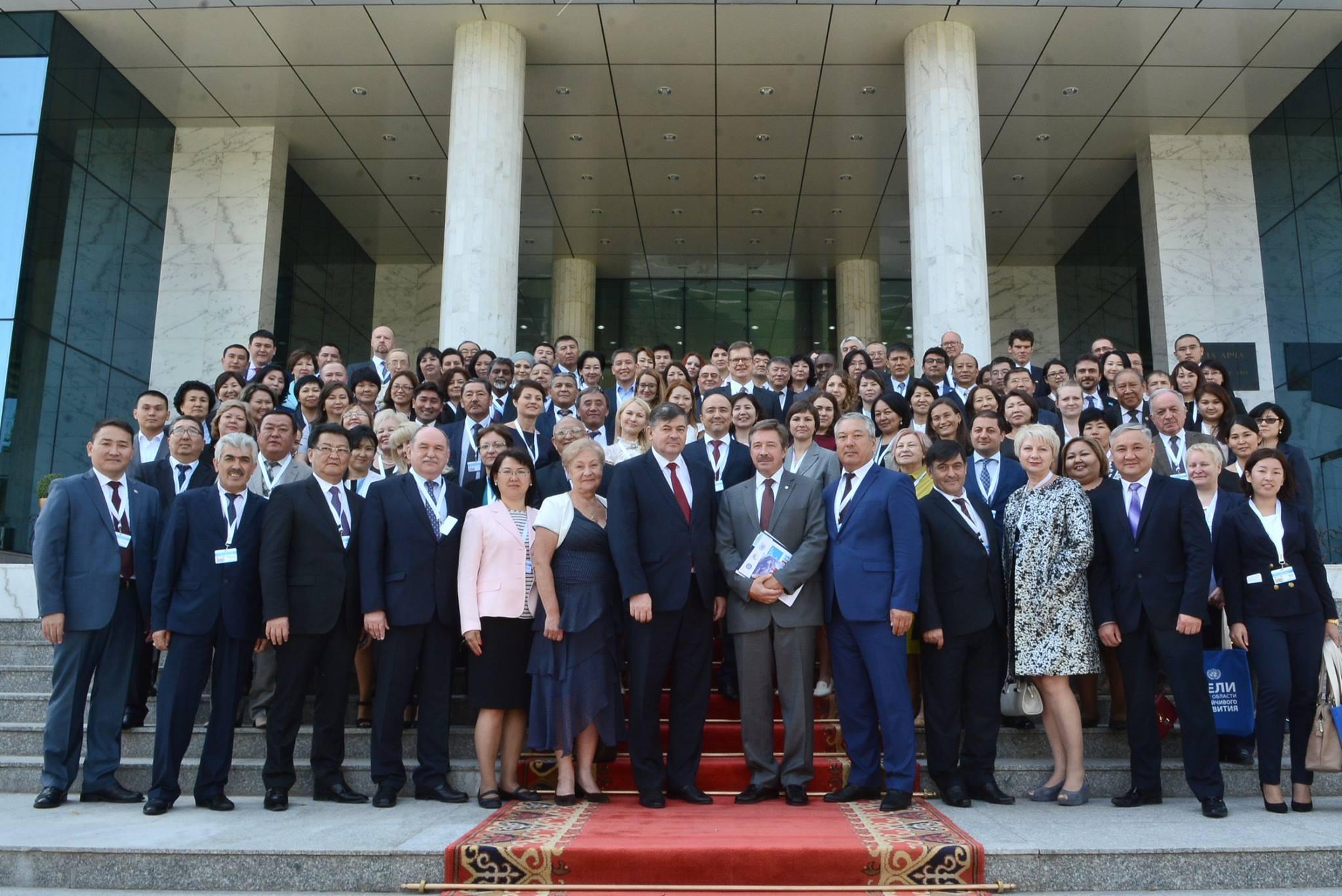
International conference on the implementation of an SDG national monitoring system organized by the National Statistics Committee of the Kyrgyz Republic, 2016.
These events were meticulously designed to serve a dual purpose. Not only did they aim to foster engagement with stakeholders, but they also functioned as valuable capacity-building exercises. The NSC made substantial efforts to enhance the overall data proficiency among its users and fellow data producers. This translated into a significant improvement in understanding and interpreting the data disseminated by NSC. In particular, the NSC played a pivotal role in elevating awareness regarding the importance of official statistics and the specific data requirements for effective SDG monitoring. Nazira, who has been instrumental in this endeavor, pointed out the specific role of the media in disseminating information among the general public. Understanding that media operates as a distinct entity, the NSC approached its engagement with them with a tailored strategy.
Recognizing that occasional disparities in data capacity might lead to varied interpretations and narratives, special training sessions were organized for media professionals. These training sessions sought to bridge the gap, with participants being divided into groups based on their interests and preferences. Each group had a dedicated representative from the NSC to collaborate in developing content enriched with statistical data. The outcome of this engagement with the media was overwhelmingly positive, underlining the significance of building their statistical capabilities. Furthermore, the NSC maintains a regular line of communication with the media through press conferences, sharing insights into the overarching socio-economic trends and the progress made towards achieving the SDGs and other key national indicators. This has fostered a network of media representatives who remain closely connected with the NSC, contributing to a more informed and data-savvy society. The media has published numerous news about the work of the NSC on the SDGs.

Screenshot from the YouTube Channel of the State Kyrgyz Media “Ala-Too 24”. News coverage about the first VNR of the Kyrgyz Republic, 2020.
In an earnest pursuit of transparency and collaboration, a dedicated working group has been established to cater to the needs of data users. This group comprises representatives from a wide spectrum of stakeholders, including government agencies, businesses, civil society, media, and the academic community. The primary aim of this initiative is to create a platform for regular exchanges and feedback, fostering an environment of constructive dialogue. This commendable effort is not a standalone activity but supplements the existing Council of Statistics, which already includes the representatives above, including the media. These dual structures contribute significantly to ensuring that data users, with their diverse perspectives and interests, are actively engaged in the decision-making processes and the development of data-related strategies.
Furthermore, recognizing the importance of enhancing the overall national capacity of the statistical system and fostering innovative ideas for refining the SDG monitoring system, the NSC, alongside other stakeholders, engaged in international workshops, seminars, and training sessions. These international platforms offered a valuable opportunity not only to learn from the successful experiences of others but also to share their own insights that could prove beneficial to fellow participants. This global interaction is a powerful reminder of the significance of looking beyond one's own system and national boundaries, Nazira shares. The exchange of knowledge and experiences on the international stage plays a pivotal role in steering progress toward the SDGs and enhancing the effectiveness of data monitoring efforts. It underscores the NSC's commitment to embracing a global perspective in their pursuit of sustainable development.
The whole SDG journey, however, was not devoid of challenges. The expansive nature of the SDGs demanded an increase in capacity and a move towards innovative data collection methods. The National Statistical Committee has been working on the seamless integration of SDG indicators into the existing statistical reporting system. As emphasized by Nazira, this is no fleeting endeavor, nor is it the sole responsibility of one department. Instead, it is an ongoing collective effort that demands the active participation of all stakeholders to stay in sync with the ever-evolving landscape of new developments, best practices, data collection methods, and data sources. While one department may act as a coordinator, the success of this endeavor hinges on the involvement of all parties. Each individual contribution, no matter how small, contributes to a larger collective effort.
In the pursuit of effectively monitoring the SDGs, the NSC embraced the challenge of tracking new indicators. These indicators encompass a diverse range of data, from assessing access to electricity to the availability of mobile phones and bank cards. To ensure the quality and consistency of this data, the NSC worked closely with government agencies, providing them with standardized templates for the collection of metadata and metrics. A substantial portion of this data is generously shared by the Ministry of Finance and the Ministry of Natural Resources, Ecology, and Technical Supervision.
Nevertheless, as NSC treads further into this intricate landscape, they acknowledge that the existing resources within the statistical system, including administrative data, have their limits. To address this, NSC initiated an exploration of innovative and non-traditional data sources. As part of a collaborative effort with the UN Statistics Division (UNSD) and Statistics Norway, training on use of geospatial data was conducted. This is particularly crucial as some indicators can only be effectively tracked through the use of geospatial data. In line with the SDG geospatial framework and overall goals of integration of geospatial and statistical training, both NSC and the National Geospatial Information Agency were trained, and data-sharing mechanisms were discussed. Kyrgyzstan was one of the first countries to make use of the SDG geospatial framework.
Additionally, NSC is delving into another promising avenue of data collection - citizen data. Collaborating with the UNSD as part of the Data, for Now, initiative, they are actively exploring the utilization of this valuable resource to enhance their understanding of the progress toward the SDGs. These initiatives reflect their commitment to leveraging the power of innovation and non-traditional data sources in the pursuit of a sustainable future.
For the Kyrgyz Republic, overall innovation is a driving force for progress. Through joint support from the UNSD and the Office of National Statistics of the UK, the country established a comprehensive platform for data and metadata dissemination. This platform offers dynamic data visualization in the form of graphs, data, and metadata for each indicator, both global and national ones, as well as supporting modern machine-readable data formats - a leap forward in data accessibility. Nazira points out that the Kyrgyz Republic was one of the pilot countries to produce data in SDMX format.
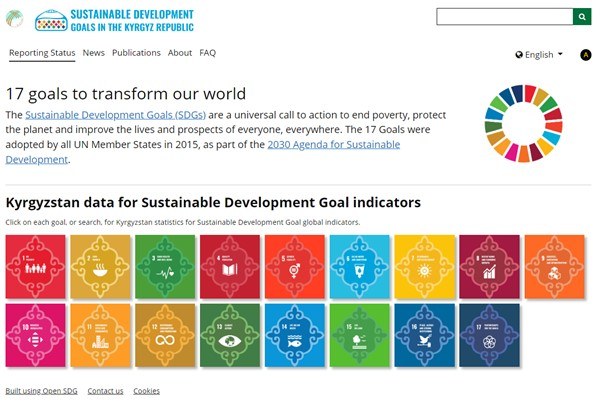
Screenshot of the SDG Platform of the Kyrgyz Republic.
The National Statistical Committee's publications, presented in engaging infographics, have further democratized access to information. These publications not only include data but also detailed methodology and trends of the indicators, making the data comprehensible and actionable for a broader audience. These publications are not standard publications of the NSC.
The NSC has prepared a number of statistical publications in such new formats. They are:
- “Monitoring SDG indicators in the Kyrgyz Republic, 2014-2018”,
- “Statistics of the Sustainable Development Goals in the Kyrgyz Republic, 2014-2020”,
- “Sustainable Development Goals and Youth in the Kyrgyz Republic, 2012-2021”,
- “Gender and Sustainable Development Goals, 2014-2021”.
The NSC was instrumental in the preparation of the first National Voluntary Review (VNR) on the SDG progress by supplying the data from the SDG platform and publications for the report. Kyrgyzstan, a trailblazer in its own right, presented its first VNR in 2020. This review showcased the nation's commitment, challenges, successes, and future directions. It covered 16 SDGs except for Goal 14 due to irrelevancy to the country. As the process and presentation of VNR coincided with the COVID-19 pandemic, the report included also information on measures taken by the country to fight the pandemic.
Nazira emphasized the importance of continuous collaboration with different stakeholders and leveraging international best practices in the preparation of the national review as well. In the lead-up to the VNR preparation events, the voice of civil society emerged as a prominent and impassioned one. They expressed a strong desire to see their data included in the VNR report. However, it became evident that the data they presented was not comprehensive, lacked national coverage, or did not align with the established methodology for the SDGs. It was imperative to engage in a thoughtful dialogue to convey the nuances of these limitations. The NSC worked diligently to reach a consensus with civil society stakeholders. The decision centered on the utilization of official statistics for the core VNR report, while civil society data would be incorporated as illustrative cases.
As the Kyrgyz Republic gears up for its second VNR, the NSC, in partnership with the UNSD, is proactively embarking on an exploration of the potential incorporation of citizen data into the report. This forward-looking initiative reflects a commitment to expanding the scope and depth of data sources, ultimately contributing to a more comprehensive and nuanced assessment of the nation's progress toward the SDGs.
Overall, the SDG monitoring propelled the Kyrgyz statistical system to evolve and communicate more effectively with more users and other data providers. According to Nazira, the impact of the SDGs extended far beyond just data collection. It brought about a perceptible shift in how the National Statistical Committee was perceived, significantly elevating its authority, influence, and trust levels among users, government bodies, and the general public. This shift in perception marked a turning point. People began to view the NSC through a different lens, recognizing the intrinsic value of the statistics it produced and the pivotal role it played in guiding the nation's development. The government itself embraced the data generated by the SDG platform, incorporating it into its reporting and decision-making processes on a regular basis.
Nazira emphasizes the paramount importance of producing "fit-for-purpose" data that genuinely serve the needs of users. This underscores the essential requirement for continuous capacity building to ensure that the data generated are not only accurate but also practical and valuable for those who rely on them. The NSC recognized the significance of effective communication and knowledge-sharing with various audiences. To this end, the government, users, and the wider public have benefited from a series of informative videos created by the NSC, which shed light on the SDGs and how to interpret and utilize them effectively. These videos come in various formats, including succinct clips suitable for social media platforms and longer, more in-depth presentations for those seeking a comprehensive understanding. Moreover, the inclusion of QR codes in the videos, as well as in NSC's brochures and publications, has proven useful in enhancing engagement and interest among users and the public. These multimedia resources have not only made data more accessible but have also fostered a deeper appreciation for the significance of the SDGs and the data that underpin them.
The SDGs indeed presented a substantial challenge, but they also brought forth remarkable advantages for the NSC. They served as a catalyst for rejuvenation and provided an invaluable opportunity for the NSC to gain prominence. The call from the United Nations to leverage official statistics as part of the SDG monitoring process breathed new life into their efforts. Another turning point for NSC was the enactment of a new Law on Official Statistics # 82 on July 8, 2019, reinforcing the drive for producing official statistics to be able to monitor the SDG progress. In embracing the SDGs, the NSC not only met a challenge head-on but also seized an opportunity to enhance its role. By aligning with the global pursuit of sustainable development and contributing their expertise in official statistics, they have played a significant role in shaping the nation's future and have risen to prominence on both national and international stages.
“I believe that all of the NSC's efforts in making data and the SDGs relevant have contributed greatly to the understanding of the role of statistics and data in evidence-based management decision-making”, shares Nazira.
Words of Wisdom for the World
Nazira leaves us with invaluable recommendations for other countries embarking or continuing their SDG voyage. They are regular engagement with users, tapping into international wisdom by studying best international practices and recommendations and applying them, enhancing statistical capacity across all domains and the system, and embracing diverse data sources.
In conclusion, the Kyrgyz Republic's voyage toward sustainable development is inspirational, illustrating that progress thrives on collaboration, innovation, and the unwavering dedication of individuals like Nazira Kerimalieva. As we continue this global pursuit of a better world, let's learn from their story and amplify our efforts to make sustainable development a reality for all.
*Ms. Nazira Kerimalieva is the First Deputy Chairman of the National Statistical Committee (NSC) of the Kyrgyz Republic. Prior to that, she served as the Head of the Sustainable Development and Environment Statistics Department at NSC for five years and was responsible for coordination of building the system of monitoring and reporting of SDG indicators.


